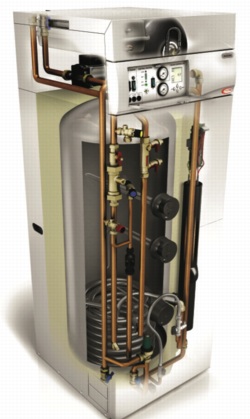Getting the best from solar thermal

Over the last few years heating engineers, specifiers and manufacturers have learned a great deal about the use of solar-thermal technology to produce domestic hot water for buildings and are now highly experienced in the area. Simon Russell looks at how to get the best out of a solar-thermal DHW system.
There is no doubt that solar thermal water heating has become the most popular renewable energy solution. The energy- and cost-saving benefits of the technology are proven, and, for many companies, having solar panels on the roof is a definite statement that here is a ‘green’ organisation.
Careful planning is important when looking to select and install a solar arrangement, and having water-heating equipment that will meet requirements is equally important. With solar gain able to provide up to 60% of domestic-hot-water requirements, the remaining 40% needs to be generated by an additional method — so an effective and efficient water heater is crucial to a successful solar thermal solution.
Solar gain will heat water in the cylinder and, where necessary, it will be brought up to the required temperature by an auxiliary heat source such as direct electric immersion heaters or a gas boiler via an indirect secondary coil in the cylinder.
In areas where there is no access to mains gas, the use of electric systems for heating and hot water can provide a solution. In addition, for multi-storey buildings, electric heating products are usually less problematic to install than mains-gas appliances as there is no requirement for flueing or, indeed, the need to provide a mains gas supply. There are generally few restrictions on the supply of electricity to buildings, and there are no condensate drainage or pluming issues either.
Electric solar packages typically comprise an electric central-heating boiler, a Megaflo [a Heatrae Sadia product] type unvented cylinder with a solar coil for maximum heat input and efficiency, solar hydraulic and electric controls, an LCD display panel and expansion vessels. Multi-functional and easy-to-use control panels make systems simple to configure, and primary solar system fluid is also included with all the necessary connecting pipework to link the cylinder to solar collectors. Alternatively, the Electromax Solar [another Heatrae Sadia product] can be specified, which is an example of a one-box solution and incorporates the complete package.
When specifying unvented cylinders, the quality and insulation of the cylinder itself is also increasingly important, as it is key to providing a more efficient operation with reduced heat losses. The new Megaflo eco, for example, has 30% lower heat loss than previous models. This has been achieved by using thermal-imagery testing techniques as part of the design and development process to identify and ensure all potential heat-radiating areas of the cylinder are covered.
Specifiers working on new-build and refurbishment projects rely on the Government’s SAP calculation tool to help them meet Building Regulations and standards.
Where the energy efficiency of hot-water cylinders is concerned, SAP as a default currently asks a specifier to enter the insulation thickness of the proposed cylinder, and this figure is then used to calculate heat loss based upon general assumptions for levels of heat loss.
The problem is that not only is the current system open to manipulation, but using insulation thickness alone to calculate heat loss does not take into account other innovations in product design which help to reduce energy demand. This means the heat loss figures provided by SAP are largely inaccurate and in some cases not as favourable as they should be.

Heat loss is the key parameter that all cylinders should be measured against so that heating engineers and specifiers can have confidence in the equipment they are selecting. To this end, clear, generic testing procedures need to be the minimum standard for our industry.
Flow rates at low pressure are also important, and this is particularly relevant in the larger conurbations where pressure can fluctuate considerably. A 3-piece inlet water valve control, allows the flexibility to site the pressure-reducing value at the mains-water entry point and ensures balanced pressure throughout all hot and cold outlets.
Several key factors need careful consideration when installing a solar system, such as the size of the building and its anticipated hot water usage. Incorrect sizing can easily lead to an inefficient system, and this is where equipment manufacturers can provide advice and support.
The siting and placement of solar-thermal panels is also important as they must face the Sun correctly; getting this wrong could lead to valuable energy being wasted. To achieve the best results, panels should be on a south-facing roof at 30 to 50° to the horizontal.
In some cases though, this can be impractical, and a variety of mounting options is available. Evacuated-tube systems can also provide a more flexible installation if required, with the ability to angle individually or be mounted on a building façade.
Undoubtedly, renewables are an increasing feature in domestic-hot-water applications, and solar packages are becoming more and more the norm. Heating engineers and specifiers can turn to manufacturers and take advantage of the wealth of knowledge and expertise they can provide.
Simon Russell is head of specification for Heatrae Sadia Heating.







